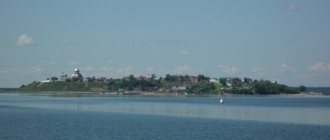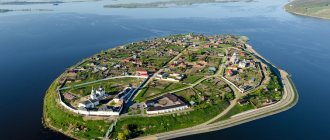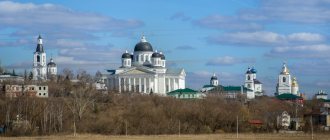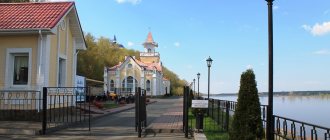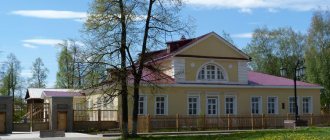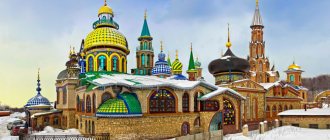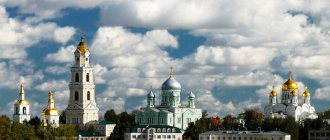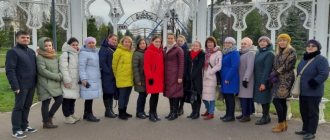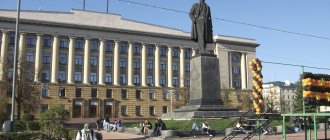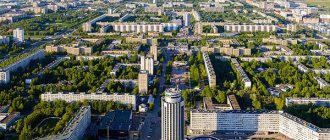The main attractions of the island-city of Sviyazhsk are, of course, the monasteries. There are three of them on the island. In addition to visiting them, there will also be a walk around Sviyazhsk and, as usual, a lot of photos.
Continuation of our walk around Sviyazhsk. The beginning is in the article: “The city of Sviyazhsk, Tatarstan - how to get there from Kazan, history and legends,” where I wrote in detail about the history of Sviyazhsk, how to get to it from Kazan and about the Mother of God Dormition Monastery, located at the entrance to the island city. It's time to look at the sights that are located in the depths of the island.
Sviyazhsky St. John the Baptist Monastery.
It is interesting that until 1917 it was female, and from 1917 to this day it has been male. The monastery was founded in the 16th century, giving it the name Rozhdestvensky. At first the buildings were made of wood, then of stone and brick, but the ancient buildings were lost due to frequent fires (1795, etc.) and reconstruction. Active work was carried out in 1796, when the bell tower and the St. John the Baptist chapel of the St. Sergius Church appeared. The monastery experienced difficult times under Soviet rule and closed in 1919. However, its entire territory is declared a museum-reserve of history and architecture; in 1959, the restoration of the central cathedral took place.
The red brick domes of the Cathedral of the Icon of Our Lady “Joy of All Who Sorrow” are visible to all guests of the island from afar. The architectural features are reminiscent of the Kronstadt Cathedral in St. Petersburg, which also has a hemispherical dome.
Construction of the cathedral took place from 1898-1906. according to the project F.N. Malinovsky, the luxurious building is made in the New Byzantine style.
Restored interior decoration of the Cathedral of the Icon of Our Lady “Joy of All Who Sorrow.” The painting is mainly done with oil paints.
Trinity Church, Sviyazhsk.
The oldest building on the territory of the monastery and the whole of Sviyazhsk is the Trinity Church, made of wood in 1551. This temple is one of the most unique objects of historical and cultural significance. Minor reconstructions were carried out only in the 19th century, when a roof and dome made of iron and a plank covering instead of a hipped roof appeared. The interior decoration has preserved the three-tiered iconostasis made of carved wood, although most of the iconographic treasures were taken to museums or to an unknown location in Soviet times.
The history of the construction of the Trinity Church is very interesting: along with the materials for the construction of the Sviyazhsk fortress, logs for this church were brought in 1551. They assembled the church within one day, as they say, “without a single nail.”
Legends call the founder of the Trinity Church Prince Nikita Serebryany, a contemporary of Grozny. There is evidence that Ivan the Terrible prayed here on the eve of the capture of Kazan.
On the territory of the monastery there is another ancient building - the Church of St. Sergius of Radonezh, or briefly the St. Sergius Church with one dome and a small belfry, built in 1604. The temple belongs to the type of refectory. Its special value is explained by the frescoes preserved on the porch, which depict Sergius of Radonezh and Alexander Svirsky. The fresco is unique, as it is a wall enlarged copy of Andrei Rublev’s work “Trinity”.
Interesting Facts. Monument to Judas
to Judas allegedly discovered on the territory of Soviet Russia.
. The installation of the monument was supposedly personally directed by Leon Trotsky. This famous revolutionary was sometimes called the "demon of the revolution."
According to legend, the format of the monument to the main biblical villain was approved by Lenin himself. It is believed that Trotsky initially wanted to erect a monument to Lucifer himself. However, Lenin banned this project, since the installation of such monuments would indirectly confirm faith in God. The project for a monument to Cain was also rejected by the leader of the world proletariat. Therefore, the revolutionaries converged on a monument dedicated to Judas.
According to legend, the opening of the monument took place with an orchestra and a parade of two Red Army regiments. After the fabric was torn from the monument, the amazed residents of the city saw a full-length stone human figure. The Judas monument depicted a crouching biblical antagonist with his arms raised. Rumor has it that the prototype of the monument was Trotsky himself.
Of course, this story is 100% fiction. Similar rumors were spread by former White Guards who were forced to immigrate from the country after the Bolshevik victory. There are quite a few references to the existence of monuments to Judas in Soviet Russia. In particular, the famous Danish diplomat Henning Koehler writes about the monument in his memoirs. He claimed to have witnessed its installation in 1918.
Let us note that many contemporaries fully trusted such rumors, since they were hostile towards the Bolsheviks. In particular, the famous Russian writer Ivan Bunin believed the information about the installation of the monument to Judas. Naturally, nothing like this ever happened.
There is a completely logical explanation for these rumors. The commander of the Red Army who took Kazan was the famous leader of the Latvian riflemen. His name was Yan Yudin
. During the fighting, this officer was killed. Moreover, the date of his death approximately coincides with the time of installation of the “monument to Judas.”
In fact, they were talking about the funeral of Yan Yudin. A monument was actually erected to him. It is known that he died from an accidental shell fired by the White Army artillery. The Dane Köhler could well have confused the consonant surname with “Judas”.
Churches, temples and cathedrals of Sviyazhsk.
Sergievskaya Church. The two-story white stone church was consecrated in 1604 in the name of Sergius of Radonezh. This building has an unusual layout: during its construction, there were utility rooms and monastic rooms on the ground floor, and the church premises themselves were on the second floor. The church has three altars, each altar is in its own chapel. Inside the church you can see a well-preserved fresco painting from the 17th century depicting the Trinity, Patriarch Nikon and Sergius of Radonezh.
Chapel in the Name of the Royal Martyrs
A landmark of Sviyazhsk, built in our time, is the chapel in the Name of the Royal Passion-Bearers, consecrated in 2004. It is dedicated to the family of the last Russian emperor, who suffered martyrdom at the hands of the Bolshevik government. At the entrance to the temple there is an icon depicting the royal family. There are many ancient icons in the chapel, some of which stream myrrh from time to time.
Cultural and natural landscape of Sviyazhsk.
Comprehensive restoration and reconstruction work in the fortress and cathedrals has been carried out in Sviyazhsk since 2010 under the “Renaissance” program; at the same time, the city’s housing stock is being updated, new premises are being built for cultural institutions, hotels, etc.
In 2021, an application was submitted for inclusion in the list of sites under the protection of UNESCO, the Assumption Monastery and the Trinity Church.
Lazy Torzhok
Lazy Torzhok is a complex of historical reconstruction. And it leaves different impressions on different people. On the one hand, there are handmade souvenirs, a historical kitchen and a photography studio.
But everything is somehow very simple, in principle there is nothing special to inspect.
Exhibition fights are usually held in this place. They are usually shown to organized groups of tourists. This is called a historical atelier.
Sviyazhsk today.
There are many buildings in Sviyazhsk that appeared in the 20-21st century, but are stylized as antique. Due to the large number of new buildings, the so-called “new build,” the island city cannot receive the status of a historical and cultural museum-reserve.
Hotel "House of Merchant Kamenev".
Some buildings from the 19th and 20th centuries have been preserved on the territory of Sviyazhsk.
The territory of the island is landscaped and beautiful, visitors feel like they are in a fairy tale on the island of Buyan.
The historical and reconstruction complex “Lazy Torzhok” consists of shopping arcades and craft shops.
Horse yard
Leaving the Lazy Torzhok, take a look at the territory of the horse yard, recognized by tourists as the highlight of Sviyazhsk.
Here you will experience the pleasure of seeing beautiful thoroughbred horses, and enjoy riding in a phaeton and on horseback. You are allowed to feed the beautiful horses and take pictures with them as a souvenir. On the horse yard there is a “Crafts Settlement”, where it is interesting to take part in master classes of potters and blacksmiths, learn how to sew leather goods, master the skills of weaving objects from birch bark or painting clay toys. Crafts Settlement is open from Friday to Sunday. The island's attractions include its amazing natural landscapes, which served as inspiration for painters of different centuries. The view of the island washed by the waters of the river, combined with the grandeur of the temples and the original architecture of civil buildings, will not leave any Russian person indifferent. Since 2007, the island has been connected to the mainland by an eight-kilometer causeway. Now you can get to this wonderful corner of Russian land not only by boat, but also by car.
Church of Constantine and Helena, Sviyazhsk
At the very shore there is the parish Church of Saints Constantine and Helena. It is visible first of all when you approach the island on a boat. The church was built at the end of the 17th century. At first the belfry was a separate building, but over time it was connected to the church, with a refectory built between them. During Soviet times, the church did not work; it opened only in the 90s. 20th century as a space for exhibition events. The church currently hosts baptisms. In the foreground is the building of the girls' gymnasium, built in 1913-14, which still houses the school.
Sviyazhsk is a sparsely populated rural settlement. In 2021 its population was only 259 people.
Story
Ivan the Terrible himself decided to build a fortified city after a series of failed operations to capture Kazan. It was necessary to create a stronghold to support the army. The island was washed on three sides by the waters of the Shchuka, Sviyaga and Volga rivers, from the elevated area - Round Mountain - distant approaches were visible, and most importantly, the island was located at a distance of a day's march from the capital of the Kazan Khanate.
The fortress was built unnoticed by the enemy. First, fortifications were built near Uglich. After that, they were dismantled and, with the onset of spring, the logs were floated along the Volga to the island, then dragged to the foot of the Round Mountain. It took one month to reassemble the fortress. The construction was led by the famous Russian architect of that time, Ivan Vyrodkov.
The city consisted of eighteen towers, residential buildings and an Orthodox church. The fortress fully fulfilled its purpose: a year after its foundation, Kazan was taken.
Houses of Sviyazhsk.
In Sviyazhsk, as well as in many cities of Tatarstan that are of historical value (Bolgar, Chistopol, Elabuga, Bugulma, etc.), there is a project “Cultural heritage: the island-city of Sviyazhsk and ancient Bolgar”, in accordance with which it is allowed to build new houses only for 5 standard projects: a house with an attic, a house with a mezzanine, a one-story house with 5 windows facing the street, etc.
The appearance of Sviyazhsk must correspond to the historical one; the houses must have dimensions and proportions in the spirit of ancient buildings.
In the process, we are developing other standard projects that will not limit the inhabitants of the island, but will help preserve the stylistic unity of the ancient city.
And behind the golden gates of the children's leisure center, interesting games and quests are held for children of preschool and school age.
How to get there
One of the main attractions of Tatarstan is located in the Zelenodolsk region of the republic, 29 km southwest of Kazan.
By bus.
On Saturdays and Sundays, the bus from Kazan to Sviyazhsk leaves at 8:40. A ticket costs 150 rubles one way.
Monument to the Victims of Political Repression
By rail.
There are 10 trains a day running from the Kazan-Pasazhirskaya station to the Sviyazhsk railway station. The journey takes 1 hour 15 minutes. From the train station the island is easily accessible by buses and taxis.
By water transport.
In summer, motor ships run daily from the River Port of Kazan to Sviyazhsk. The journey by water lasts 2 hours.
Children's
By car.
The distance from Kazan to the city-island by road is 58 km. Tourists leave the city along the M7 highway towards Moscow, and after Isakovo they turn right towards Sviyazhsk.
Attraction rating
Rating 3.33 [3 vote(s)]
| ← RUSSIA | REPUBLIC OF TATARSTAN | EUROPE → |
Museum of Sviyazhsk.
The “Devka’s Head” cannon, recreated from ancient images, is installed in front of the entrance to the Museum of the History of Sviyazhsk. The museum houses rich exhibitions dedicated to the history of the island, including stories about the activities of the saints revered here, as well as archaeological and military history. The museum has halls for conducting interactive classes, they are equipped with a soldier's hut, an official's office, a monastic cell, a gymnasium classroom, models of ancient houses and steamships, etc. are presented. All exhibits of the interactive space are available to visitors who come here for thematic classes and game meetings.
At the end of the street is the Gate Bell Tower in the Sviyazhsk Mother of God Assumption Monastery, which means that we have walked around Sviyazhsk and are returning back to the car.
We are leaving the island of Sviyazhsk - an amazing museum-reserve. This is just a small dot on the map of the Republic of Tatarstan, but it is an important and eventful period in the history of our country.
